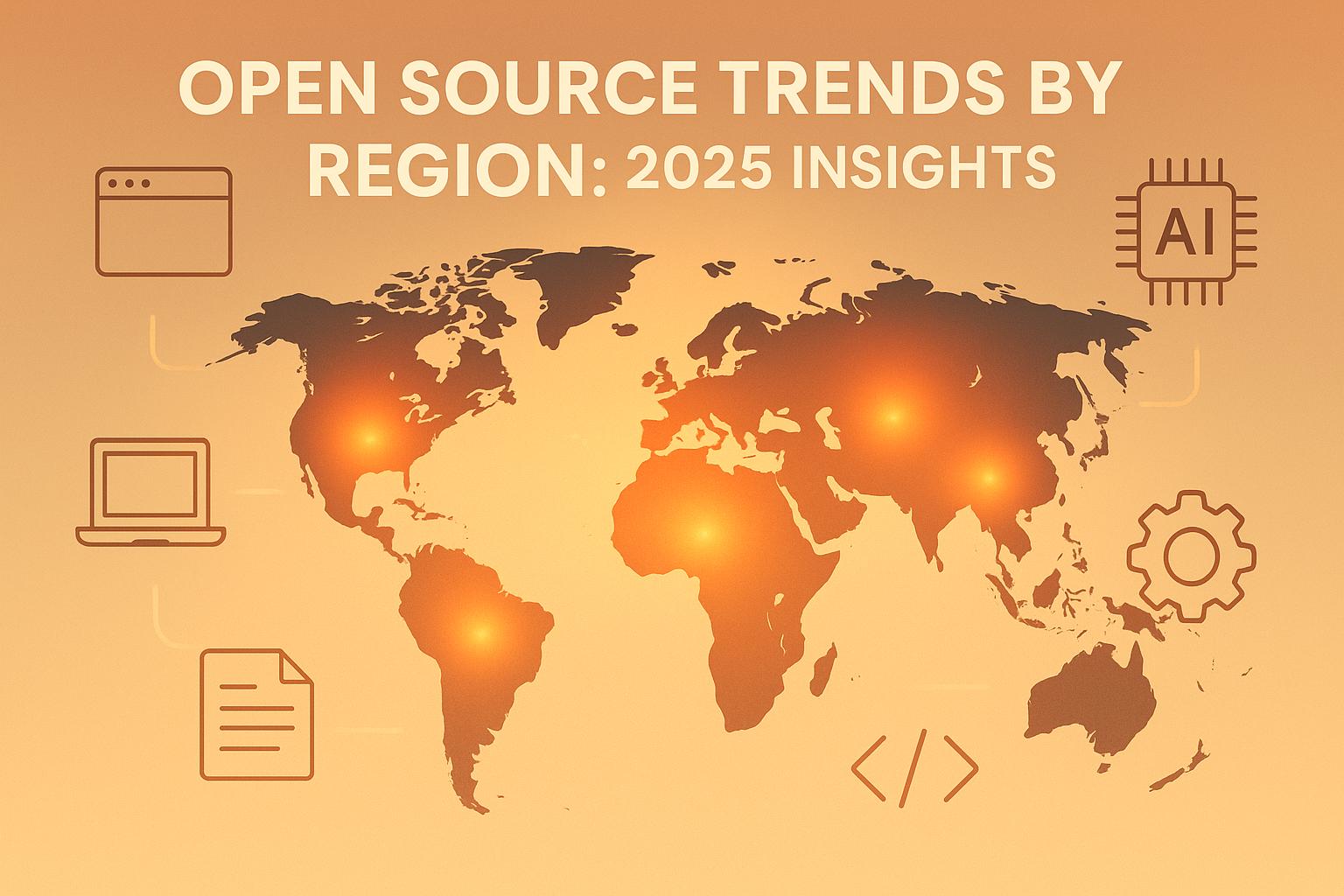


Explore how regional factors shape global open source contributions and collaboration in 2025, highlighting the role of digital tools and AI.
Open source is evolving globally in 2025, with regional contributions playing a key role. Here's what you need to know:
- Developers worldwide are participating in open source projects, moving beyond traditional tech hubs.
- Digital tools now enable seamless collaboration across regions, overcoming time zones and communication challenges.
- AI tools and energy-efficient practices are reshaping workflows, making contributions smoother and more sustainable.
- Local factors like education, economy, and developer experience influence how regions contribute to projects.
- Platforms like daily.dev help businesses connect with developers by targeting specific regions, languages, and tools.
Understanding regional trends is essential for engaging with diverse developer communities and supporting the global open source movement.
USA vs. The World: Who REALLY Builds Open Source Software?
Open Source Contributions by Region
Open source development in 2025 reflects a truly global effort. While detailed regional statistics are still on the horizon, platforms like daily.dev showcase a thriving international community. This highlights a growing trend: digital collaboration that transcends borders. Let’s explore how contributions from around the world are shaping this movement.
Contribution Data by Region
Although specific regional data is scarce, the activity observed on developer platforms underscores one key fact: open source innovation is no longer limited to traditional tech hubs. Developers from all corners of the globe are now able to contribute in ways that were once unimaginable. The rise of digital tools has made geography less relevant, opening the door for unique contributions from diverse regions. These patterns hint at a broader shift, one that’s reshaping the global open source landscape.
Top Countries and Major Changes
While detailed country-level data isn’t yet available, future studies are expected to shed light on how participation is changing and which regions are emerging as leaders in the field. What’s clear for now is that open source collaboration is no longer concentrated in a handful of locations. Developers from a wide range of countries are actively engaging in projects, bringing fresh perspectives and ideas.
This worldwide participation is not just a trend - it’s becoming the foundation for the next wave of progress in software development. By embracing contributions from a diverse and distributed community, open source is poised to become even more dynamic and inclusive in the years to come.
How Regions Collaborate on Open Source Projects
The way regions work together on open source projects offers a fascinating glimpse into the ever-changing nature of collaboration in the tech world.
By 2025, open source collaboration has expanded across both regional and global lines. While time zones and differences in communication styles can pose challenges, digital tools have made remote teamwork much more manageable.
Cross-Border Project Teams
Today’s developers often form teams that span multiple continents. They rely on digital platforms and flexible workflows to keep projects moving smoothly. These teams adjust their processes to respect different communication styles, ensuring that work remains efficient and coordinated across various regions.
Regional vs. Global Collaboration Models
The open source community has developed different approaches to collaboration. Some projects focus on regional teams to make scheduling easier, while others tap into a global network of contributors to ensure continuous progress. Larger projects often combine the two, using regional clusters for day-to-day work and global coordination for big-picture decisions.
Platforms like daily.dev emphasize how open source projects succeed by adapting to local working conditions. These evolving collaboration methods shed light on the local factors that encourage participation and keep the community thriving.
sbb-itb-e54ba74
What Drives Regional Open Source Participation
Regional collaboration patterns are influenced heavily by local factors, including economic conditions, education systems, and societal attitudes. These factors play a significant role in shaping how developers contribute to open source projects.
For instance, the strength of a region's tech ecosystem and socio-economic environment directly impacts participation. Differences in cultural norms, access to economic opportunities, and the focus of educational programs influence the types of contributions developers make and their level of engagement. Additionally, local variations in developer experience, gender representation, and organizational support contribute to the diversity of open source participation.
Businesses looking to connect with these varied developer communities can use platforms like daily.dev. These tools allow companies to tailor their outreach efforts to specific regional developer profiles, enabling targeted advertising that resonates with developers in different parts of the world. This approach helps align with the unique characteristics and needs of each community.
Future Trends by Region
By 2025, open source development is embracing new tools and more efficient ways of working together. These changes are transforming how communities rally around shared goals and how businesses connect with a growing and diverse developer audience.
AI Tools and Energy-Efficient Development
New AI tools are making open source workflows smoother with coding assistants and automation. At the same time, there's a growing focus on cutting down computational overhead and energy use. While specific regional data is scarce, these trends indicate that both smart automation and sustainable development will likely play a bigger role in the open source world as the year unfolds. This shift opens the door to tailored outreach and fresh ways to engage with developers.
Reaching Developers by Region
The diversity of regional development practices creates both unique opportunities and challenges for engaging open source communities. These evolving technical trends demand marketing strategies that can connect with developers worldwide in a precise and meaningful way.
daily.dev Ads gives businesses a powerful way to target developers in line with these shifting trends. With a global reach of over 1,000,000 developers - impacting 1 in 50 developers worldwide - the platform offers hyper-local geographic targeting options. This allows companies to craft messages that resonate with the distinct characteristics of specific regions.
But it doesn’t stop at geography. The platform also enables targeting based on programming languages, seniority levels, and tools, helping businesses align their campaigns with the unique needs of local tech ecosystems.
Native ad placements, like In-Feed Native Ads and Post Page Ads, grab developers' attention when they’re actively exploring tools or engaging in technical discussions. This method works particularly well for reaching developers across different time zones and cultural contexts, ensuring ads are seen within trusted, relevant content.
For businesses rolling out new tools or hosting events, daily.dev Ads can drive product adoption, boost brand visibility, and increase attendance at conferences or meetups aimed at specific audiences.
Additionally, the platform’s 40% power user base includes highly engaged developers who often play key roles in open source projects and serve as influential voices in their communities. Targeting this group with well-crafted campaigns can create a ripple effect, amplifying impact far beyond the initial ad interaction.
As regional development practices continue to evolve, leveraging daily.dev Ads allows businesses to connect with diverse developer communities while supporting local growth and innovation.
Key Takeaways on Regional Open Source Trends in 2025
As we look toward 2025, regional differences are shaping a globally connected open source community that sparks creativity and drives business collaboration. Recognizing these regional characteristics is crucial for organizations aiming to build strong relationships with developers around the world.
Geographic diversity plays a major role in fueling innovation within open source projects. Each region brings its own unique perspectives, technical methods, and collaboration styles, creating opportunities for more tailored and impactful engagement strategies.
Platforms like daily.dev, which connect millions of developers worldwide, highlight the effectiveness of localized outreach. By understanding regional preferences - such as favored programming languages, developer experience levels, and commonly used tools - organizations can craft messaging that resonates deeply with specific audiences. This approach is summed up perfectly by Nimrod Kramer of daily.dev:
"The ideal platform reaches developers when they're in discovery mode - on desktop, during work hours, with hyper-targeted, relevant ads."
– Nimrod Kramer, daily.dev
Timing and context are equally important. Developers in different regions have distinct work patterns and peak engagement times. Outreach efforts that align with these schedules tend to see greater success, whether the goal is boosting product adoption, increasing brand visibility, or encouraging community involvement.
FAQs
How do factors like education and the economy shape regional contributions to open source in 2025?
Local elements like education quality and economic stability heavily influence regional participation in open source projects. Areas with robust educational systems tend to cultivate skilled developers who are more inclined to contribute to open source initiatives. Likewise, regions with stable economies often have the resources and infrastructure that nurture developer communities and encourage collaboration.
By 2025, these factors are shaping a global landscape of diverse contributions. Some regions are diving into cutting-edge technologies, while others focus on practical, community-oriented solutions. This underscores the need to adapt developer support to align with local strengths and challenges.
How are AI tools and energy-efficient practices shaping open source collaboration across regions in 2025?
AI tools and eco-friendly practices are reshaping the way open source communities collaborate worldwide. By automating repetitive tasks and offering smart insights, AI simplifies workflows and improves code quality. This frees up developers to concentrate on tackling more complex and creative challenges.
At the same time, energy-efficient approaches, like using greener cloud infrastructure and fine-tuning software to consume fewer resources, are gaining traction. These measures help minimize environmental impact while aligning with global efforts toward sustainability. They also encourage more equitable and responsible participation across diverse regions.
How can businesses connect with global developer communities using daily.dev?
Looking to reach developers around the world? daily.dev Ads makes it simple with targeted ad campaigns that align perfectly with developers' interests, skill levels, preferred programming languages, and tools. This means your message lands right where it matters most.
The platform provides native ad placements, including in-feed ads, post page ads, and soon-to-launch personalized digest ads, all crafted to boost visibility and interaction. Whether you're promoting tools, events, or resources, daily.dev connects your business to a trusted and engaged developer community.






